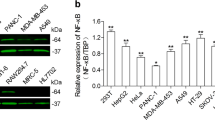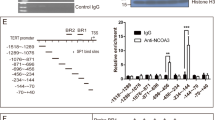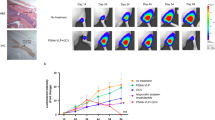Abstract
Sodium iodide symporter (NIS)-based radionuclide therapy provides an effective means of treating malignant tumors. However, it is sometimes inadequate because of limited effects on radio-resistant tumors, and thus, combination therapies with other therapeutic options have been requested to enhance its efficacy. Human telomerase reverse transcriptase (hTERT) has been reported to be involved in the progression of most cancers and also been viewed as a good candidate for targeting tumor. Application of TERT-specific radionuclide therapies using NIS gene transfer have been reported to treat TERT-positive tumors, but this approach only demonstrated tumor regression rather than eradication. As inhibiting TERT expression by introducing the hTERT-specific shRNA (siTERT) has been suggested as a therapeutic option, we investigated the complementary role of siTERT treatment after the TERT-specific I-131 therapy and its possibility as a novel anticancer therapeutic strategy. Retroviruses containing TERT promoter/NIS for TERT specific Radionuclide therapy and siTERT for TERT targeting antisense therapy were produced. Hep3B cells expressing TERT specific NIS (Hep3B-TERT/NIS) were xenografted into nude mouse and visualized with micro-SPECT/CT for monitoring NIS activity. The levels of hTERT mRNA, protein and its activity were confirmed by RT-PCR, Western blotting and Telomerase repeat amplification protocol assay. Cell proliferation was monitored by MTT assay and induced apoptosis was confirmed by Annexin-V-PI staining. Therapeutic effects of I-131 and/or siTERT were evaluated by clonogenic assay and mouse tumor model. Reduction of hTERT mRNA, protein and TERT activity by siTERT were observed in Hep3B-TERT/NIS cells. The viabilities of the infected cells were significantly decreased to 50% versus siScramble treated controls. The early apoptotic cell population was increased by siTERT. The survival rates of cells treated with siTERT or I-131 alone were 72.4±7.6% and 56.2±5.2%, respectively. However, the survival rate of cells treated with I-131 and siTERT were decreased to 22.1±2.8%. From mouse xenograft model, we also found that the siTERT gene therapy showed synergism to the radioiodine therapy for reducing tumor growth in vivo. Our Results suggested that complementary siTERT gene therapy offers a novel strategy of cancer therapy to improve the therapeutic efficacy of TERT-specific I-131.
This is a preview of subscription content, access via your institution
Access options
Subscribe to this journal
Receive 12 print issues and online access
$259.00 per year
only $21.58 per issue
Buy this article
- Purchase on Springer Link
- Instant access to full article PDF
Prices may be subject to local taxes which are calculated during checkout





Similar content being viewed by others
References
Lee YL, Lee YJ, Ahn SJ, Choi TH, Moon BS, Cheon GJ et al. Combined radionuclide–chemotherapy and in vivo imaging of hepatocellular carcinoma cells after transfection of a triple-gene construct, NIS, HSV1-sr39tk, and EGFP. Cancer Lett 2010; 290: 129–138.
Park SY, Kwak W, Thapa N, Jung MY, Nam JO, So IS et al. Combination therapy and noninvasive imaging with a dual therapeutic vector expressing MDR1 short hairpin RNA and a sodium iodide symporter. J Nucl Med 2003; 49: 1480–1488.
Shay JW, Keith WN . Targeting telomerase for cancer therapeutics. Br J Cancer 2008; 98: 677–683.
Tarkanyi I, Horváth A, Szatmari I, Eizert H, Vámosi G, Damjanovich S et al. Inhibition of human telomerase by oligonucleotide chimeras, composed of an antisense moiety and a chemically modified homo-oligonucleotide. FEBS Lett 2005; 6: 1411–1416.
Kurvinen K, Rantanen V, Syrjänen S, Johansson B . Radiation-induced effects on telomerase in gynecological cancer cell lines with different radiosensitivity and repair capacity. Int J Radiat Biol 2006; 82: 859–867.
Kim SH, Chung HK, Kang JH, Kim KI, Jeon YH, Jin YN et al. Tumor-targeted radionuclide imaging and therapy based on human sodium iodide symporter gene driven by a modified telomerase reverse transcriptase promoter. Hum Gene Ther 2008; 19: 951–957.
Takeshita F, Ochiya T . Therapeutic potential of RNA interference against cancer. Cancer Sci 2006; 97: 689–696.
Jia F, Zhang YZ, liu C . A retrovirus-based system to stably silence hepatitis B virus genes by RNA interference. Biotechnol Lett 2006; 28: 1679–1685.
Zhao P, Wang C, Fu Z, You Y, Cheng Y, Lu X et al. Lentiviral vector mediated siRNA knock-down of hTERT results in diminished capacity in invasiveness and in vivo growth of human glioma cells in a telomere length-independent manner. Int J Oncol 2007; 31: 361–368.
Pallini R, Sorrentino A, Pierconti F, Maggiano N, Faggi R, Montano N et al. Telomerase inhibition by stable RNA interference impairs tumor growth and angiogenesis in glioblastoma xenografts. Int J Cancer 2006; 118: 2158–2167.
Guo Y, Xie J, Rubin E, Tang YX, Lin F, Zi X et al. Frzb, a secreted Wnt antagonist, decreases growth and invasiveness of fibrosarcoma cells associated with inhibition of Met signaling. Cancer Res 2008; 68: 3350–3360.
Kim E, Kim JH, Shin HY, Lee H, Yang JM, Kim J et al. Ad-mTERT-delta19, a conditional replication-competent adenovirus driven by the human telomerase promoter, selectively replicates in and elicits cytopathic effect in a cancer cell-specific manner. Hum Gene Ther 2003; 14: 1415–1428.
Hahn WC . Telomerase and Cancer: Where and When? Clin Cancer Res 2001; 7: 2953–2954.
Ahn SJ, Jeon YH, Lee YJ, Lee YL, Lee SW, Ahn BC et al. Enhanced anti-tumor effects of combined MDR1 RNA interference and human sodium/iodide symporter (NIS) radioiodine gene therapy using an adenoviral system in a colon cancer model. Cancer Gene Ther 2010; 17: 492–500.
Poole JC, Andrews LG, Tollefsbol TO . Activity, function, and gene regulation of the catalytic subunit of telomerase (hTERT). Gene 2001; 269: 1–12.
Liao Z, Huang C, Zhou F, Xiong J, Bao J, Zhang H et al. Radiation enhances suicide gene therapy in radioresistant laryngeal squamous cell carcinoma via activation of a tumor-specific promoter. Cancer Lett 2009; 283: 20–28.
EI-Daly H, Kull M, Zimmermann S, Pantic M, Waller CF, Martens UM . Selective cytotoxicity and telomere damage in leukemia cells using the telomerase inhibitor BIBR1532. Blood 2005; 105: 1742–1749.
Gellert G, Dikmen Z, Wright W, Gryaznov S, Shay J . Effects of a novel telomerase inhibitor, GRN163L, in human breast cancer. Breast Cancer Res Treat 2006; 96: 73–81.
Saretzki G, Ludwig A, von Zglinicki T, Runnebaum IB . Ribozyme-mediated telomerase inhibition induces immediate cell loss but not telomere shortening in ovarian cancer cells. Cancer Gene Ther 2001; 8: 827–834.
Dong X, Liu A, Zer C, Feng J, Zhen Z, Yang M et al. siRNA inhibition of telomerase enhances the anti-cancer effect of doxorubicin in breast cancer cells. BMC Cancer 2009; 9: 133.
Zhang PH, Zou L, Tu ZG . RNAi-hTERT Inhibition hepatocellular carcinoma cell proliferation via decreasing telomerase activity. J Surg Res 2006; 131: 143–149.
Bauer G, Dao MA, Case SS, Meyerrose T, Wirthlin L, Zhou P et al. In vivo biosafety model to assess the risk of adverse events from retroviral and lentiviral vectors. Mol Ther 2008; 16: 1308–1315.
Acknowledgements
We gratefully thank Chae-Ok Yun (Yonsei University) for providing 5 mmTERT promoter and acknowledge Hyunjung Kim for assisting virus production. This work was supported by the National Research Foundation of Korea (NRF) funded by the Korean government (Ministry of Education, Science and Technology) Grant No. 20110002308 and 20110002928.
Author information
Authors and Affiliations
Corresponding authors
Ethics declarations
Competing interests
The authors declare no conflict of interest.
Rights and permissions
About this article
Cite this article
Kim, S., Youn, H., Song, M. et al. Complementary treatment of siTERT for improving the antitumor effect of TERT-specific I-131 therapy. Cancer Gene Ther 19, 263–270 (2012). https://doi.org/10.1038/cgt.2011.88
Received:
Revised:
Accepted:
Published:
Issue Date:
DOI: https://doi.org/10.1038/cgt.2011.88



